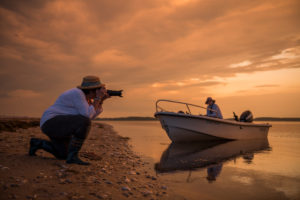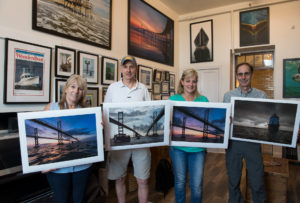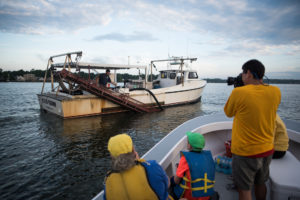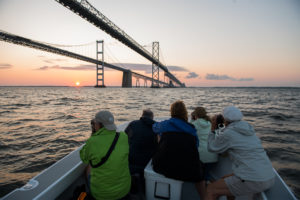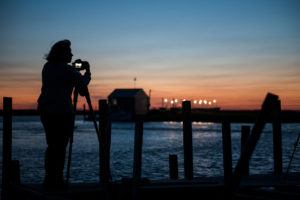Photo by Gary Reich
Photographer Jay Fleming Continues His Documentation Of The Chesapeake, While Sharing His Passion With Others
Chances are, you know of Jay Fleming or his work. If somehow neither was true prior to reading this issue, you clearly do now. His contribution to Coastal Style’s “Oyster Issue” was significant — and is his documentation of the Chesapeake Bay, its islands, its wildlife, and most important to Jay, its people.
Jay‘s first published book, Working the Water, revealed the mystique surrounding the seafood harvest in the Bay by taking the reader on a visual journey with the watermen as they harvested oysters, clams, fish and crabs. He spent three years actively documenting the fascinating and rapidly changing way of life of those who make their living from the Bay’s resources. Organized chronologically by season, Working the Water illustrates a behind-the-scenes view of commercial fisheries not visible to the average seafood consumer.
Jay discovered his passion for photography upon inheriting his father’s (former National Geographic photographer Kevin Fleming) hand-me-down Nikon film camera at the age of 13. Jay immediately developed an affinity for looking at life through the lens of his camera, and what ensued was an exciting photographic journey that would eventually lead him to his career as a professional photographer.
Since 2015, he’s been sharing this passion and talents for amateur photography enthusiasts through a series of workshops, ones in which he personally guides his students through the waters he cherishes — sharing his expertise of the subject matter and how to effectively capture personally unique images. A U.S. Coast Guard-licensed boat captain, Jay has over 400 documented days on the water during the past five years.
His one-day workshop is set on the waters of his hometown, Annapolis. At sunrise, Jay and his students depart to photograph iconic watermarks near the mouth of the Severn River. Participants photograph the Chesapeake Bay Bridge, working watermen, and the Sandy Point and Thomas Point Lighthouses. After the morning session, students meet Jay at his studio to review their work, where he provides professional tutorials on editing, retouching and studio workflow. Each student then prints one of their select photographs on Jay’s large- format Epson printer as a memorable keepsake.
Jay also hosts three-day excursions to the Eastern Shore of Virginia and on Smith, Tangier and Hooper’s Islands. Here, Jay provides students one-of-a-kind opportunities to photograph wildlife, working waterman and the island community. Participants are fully immersed into the island’s way of life — conversing with the residents, eating locally harvested seafood and becoming familiar with the island’s waterways.
In-between assignments for this issue, we asked Jay more about his workshops, as well as a few questions relating to the 2021 release of this book, Island Life. Through photography and prose, Fleming explores the rich environment, and culture of Smith and Tangier, the last two inhabited offshore islands in the Chesapeake Bay.
What’s your favorite workshop location and why?
Smith Island on the Chesapeake Bay. The subjects to photograph, from the working watermen to the wildlife, keep photographers of all skill levels busy. The Brown Pelican nesting colony on the island is a favorite among wildlife photographers. What makes Smith Island even more special is the generous hospitality of the islanders. They have a way of making me and my photography students feel at home during trips.
Are you sometimes surprised at how much a student can actually improve their skills during a workshop?
Absolutely. Students improve their photography skills and come away with great images over the course of a three-day trip. My focus with the workshops is to put the students in the right place with the right lighting to capture a great photograph.
What’s the most rewarding aspect of sharing your talents and expertise with amateur photographers?
Some of the most rewarding experiences from the workshops are watching the photography students experience something for the first time. I am out on the water 150-plus days a year, so another sunrise for me might not mean much, but for someone who is rarely able to get out, it is very special.
When will you publish 2020 workshop dates?
I will be releasing my 2020 schedule this fall.
After 10 years of documenting Tangier and Smith Islands, what continues to draw you back for your upcoming book, Island Life?
Since my first trip to Smith Island in the spring of 2009, I have made over 75 trips to the islands. On every trip, I try to focus on documenting and learning about something different. The islands and their communities are constantly changing, and documenting them now is very important.
How would you describe the people of the islands?
The islanders have been incredibly generous in allowing me to be part of their unique way of life. Their hospitality has allowed me to document the communities in ways that I never thought I would be able to. The isolation from the mainland has preserved the traditional ways of life of the communities. Unlike other islands on the bay, Smith and Tangier do not have a bridge that connects them to the mainland.
What’s the greatest aspect of photography in general for you?
Photography is the vehicle that takes me to amazing places around the Chesapeake Bay and the Delmarva Peninsula — it is the motivation to keep exploring.
By Jonathan Westman

